Lexus GX460 2012 Owner's Manual
Manufacturer: LEXUS, Model Year: 2012, Model line: GX460, Model: Lexus GX460 2012Pages: 839, PDF Size: 11.4 MB
Page 361 of 839

359
2-5. Driving information
2
When driving
GX460_U.S.A. (OM60J00U)
Capacity and distributionCargo capacity depends on the total weight of the occupants.
(Cargo capacity) = (Total load capacity) — (Total weight of occupants)
Steps for Determining Correct Load Limit —
(1) Locate the statement “The combined weight of occupants and cargo should never exceed XXX kg or XXX lbs.” on your vehicle’s
placard.
(2) Determine the combined weight of the driver and passengers that will be riding in your vehicle.
(3) Subtract the combined weight of the driver and passengers from XXX kg or XXX lbs.
(4) The resulting figure equals the available amount of cargo and lug- gage load capacity.
For example, if the “XXX” amount equals 1400 lbs. and there will be
five 150 lb passengers in your vehicle, the amount of available cargo
and luggage load capacity is 650 lbs. (1400 - 750 (5 × 150) = 650
lbs.)
(5) Determine the combined weight of luggage and cargo being
loaded on the vehicle. That weight may not safely exceed the avail-
able cargo and luggage load capacity calculated in Step 4.
(6) If your vehicle will be towing a trailer, load from your trailer will be transferred to your vehicle. Consult this manual to determine how
this reduces the available cargo and luggage load capacity of your
vehicle. ( →P. 364)
Page 362 of 839

360
2-5. Driving information
GX460_U.S.A. (OM60J00U)
Example based on your vehicleCargo capacity
Total load capacity
When 2 people with the combined weight of 366 lb. (166 kg) are riding
in your vehicle, the available amount of cargo and luggage load capacity
will be as follows:
Vehicles without rear heig ht control air suspension
With third seats — total load capacity: 1315 lb. (595 kg)
1315 lb. - 366 lb. = 949 lb. (595 kg - 166 kg = 429 kg)
Without third seats
— total load capacity: 1525 lb. (690 kg)
1525 lb. - 366 lb. = 1159 lb. (690 kg - 166 kg = 524 kg)
Vehicles with rear height control air suspension
Total load capacity: 1280 lb. (580 kg)
1280 lb. - 366 lb. = 914 lb. (580 kg - 166 kg = 414 kg)
In this condition, if 3 more passengers with the combined weight of 388 lb.
(176 kg) get on, the available cargo and luggage load will be reduced as follows:
Page 363 of 839

361
2-5. Driving information
2
When driving
GX460_U.S.A. (OM60J00U)Vehicles without rear height control air suspension
With third seats
949 lb. - 388 lb. = 561 lb. (429 kg - 176 kg = 253 kg)
Without third seats
1159 lb. - 388 lb. = 771 lb. (524 kg - 176 kg = 348 kg)
Vehicles with rear heig
ht control air suspension
914 lb. - 388 lb. = 526 lb. (414 kg - 176 kg = 238 kg)
As shown in the example above, if the number of occupants increases,
the cargo and luggage load will be reduced by an amount that equals the
increased weight due to the additional occupants. In other words, if an
increase in the number of occupants causes an excess of the total load
capacity (combined weight of occupants plus cargo and luggage load),
you must reduce the cargo and luggage on your vehicle.
CAUTION
■Things that must not be carried in the luggage compartment
The following things may cause a fire if loaded in the luggage compartment:
●Receptacles containing gasoline
●Aerosol cans
Page 364 of 839
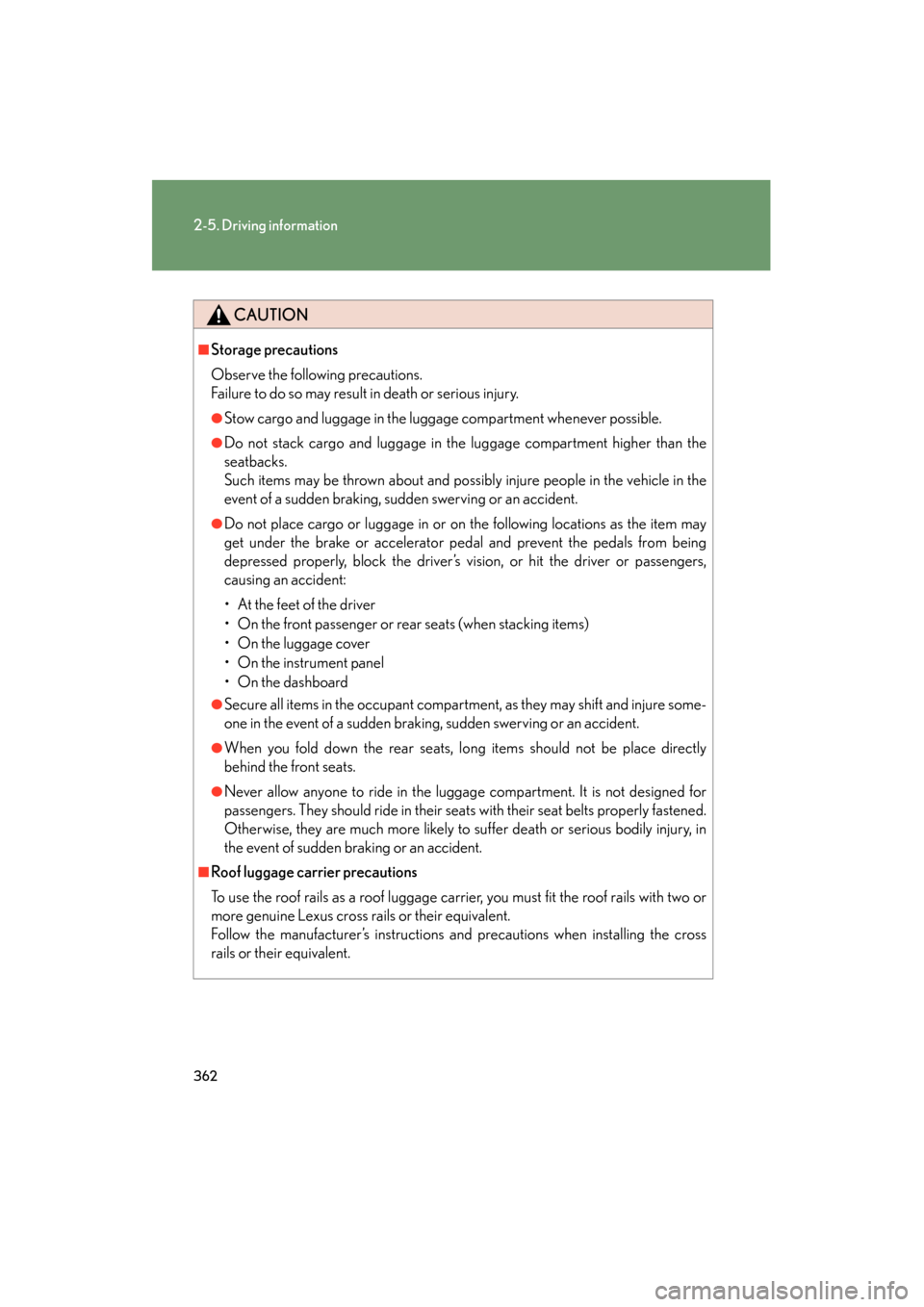
362
2-5. Driving information
GX460_U.S.A. (OM60J00U)
CAUTION
■Storage precautions
Observe the following precautions.
Failure to do so may result in death or serious injury.
●Stow cargo and luggage in the luggage compartment whenever possible.
●Do not stack cargo and luggage in the luggage compartment higher than the
seatbacks.
Such items may be thrown about and possibly injure people in the vehicle in the
event of a sudden braking, sudden swerving or an accident.
●Do not place cargo or luggage in or on the following locations as the item may
get under the brake or accelerator pedal and prevent the pedals from being
depressed properly, block the driver’s vision, or hit the driver or passengers,
causing an accident:
• At the feet of the driver
• On the front passenger or rear seats (when stacking items)
• On the luggage cover
• On the instrument panel
•On the dashboard
●Secure all items in the occupant compartment, as they may shift and injure some-
one in the event of a sudden braking, sudden swerving or an accident.
●When you fold down the rear seats, long items should not be place directly
behind the front seats.
●Never allow anyone to ride in the luggage compartment. It is not designed for
passengers. They should ride in their seats with their seat belts properly fastened.
Otherwise, they are much more likely to suffer death or serious bodily injury, in
the event of sudden braking or an accident.
■Roof luggage carrier precautions
To use the roof rails as a roof luggage carrier, you must fit the roof rails with two or
more genuine Lexus cross rails or their equivalent.
Follow the manufacturer’s instructions and precautions when installing the cross
rails or their equivalent.
Page 365 of 839
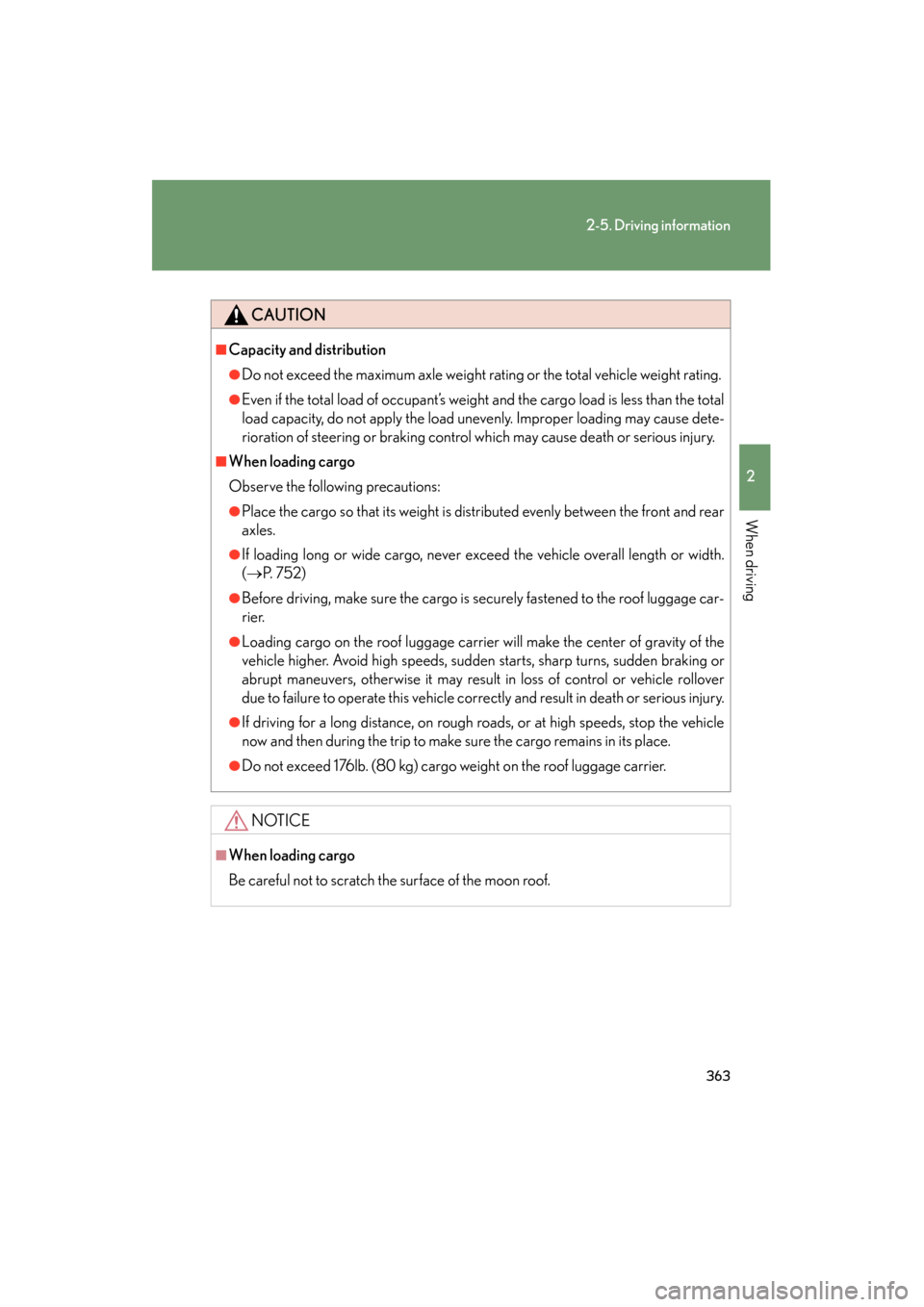
363
2-5. Driving information
2
When driving
GX460_U.S.A. (OM60J00U)
CAUTION
■Capacity and distribution
●Do not exceed the maximum axle weight rating or the total vehicle weight rating.
●Even if the total load of occupant’s weight and the cargo load is less than the total
load capacity, do not apply the load unevenly. Improper loading may cause dete-
rioration of steering or braking control which may cause death or serious injury.
■When loading cargo
Observe the following precautions:
●Place the cargo so that its weight is distributed evenly between the front and rear
axles.
●If loading long or wide cargo, never exceed the vehicle overall length or width.
(→ P. 7 5 2 )
●Before driving, make sure the cargo is securely fastened to the roof luggage car-
rier.
●Loading cargo on the roof luggage carrier will make the center of gravity of the
vehicle higher. Avoid high speeds, sudden starts, sharp turns, sudden braking or
abrupt maneuvers, otherwise it may result in loss of control or vehicle rollover
due to failure to operate this vehicle correctly and result in death or serious injury.
●If driving for a long distance, on rough roads, or at high speeds, stop the vehicle
now and then during the trip to make sure the cargo remains in its place.
●Do not exceed 176lb. (80 kg) cargo weight on the roof luggage carrier.
NOTICE
■When loading cargo
Be careful not to scratch the surface of the moon roof.
Page 366 of 839

364
2-5. Driving information
GX460_U.S.A. (OM60J00U)
Vehicle load limits
Vehicle load limits include total load capacity, seating capacity, towing
capacity and cargo capacity.
■Total load capacity:
Vehicles without rear height control air suspension
With third seats — 1315 lb. (595 kg)
Without third seats — 1525 lb. (690 kg)
Vehicles with rear height control air suspension 1280 lb. (580 kg)
Total load capacity means the combined weight of occupants, cargo
and luggage.
■ Seating capacity:
With third seats — 7 occupants (Front 2, Rear 5)
Without third seats — 5 occupants (Front 2, Rear 3)
Seating capacity means the maximu m number of occupants whose
estimated average weight is 150 lb. (68 kg) per person.
■ Towing capacity: 6500 lb. (2948 kg)
Towing capacity means the maximum gross trailer weight (trailer
weight plus its cargo weight) that your vehicle is able to tow.
■ Cargo capacity
Cargo capacity may increase or decrease depending on the weight
and the number of occupants.
Page 367 of 839

365
2-5. Driving information
2
When driving
GX460_U.S.A. (OM60J00U)
■Total load capacity and seating capacity
These details are also described on the tire and loading information label.
(→ P. 6 3 5 )
CAUTION
■Overloading the vehicle
Do not overload the vehicle.
It may not only cause damage to the tires, but also degrade steering and braking
ability, resulting in an accident.
Page 368 of 839
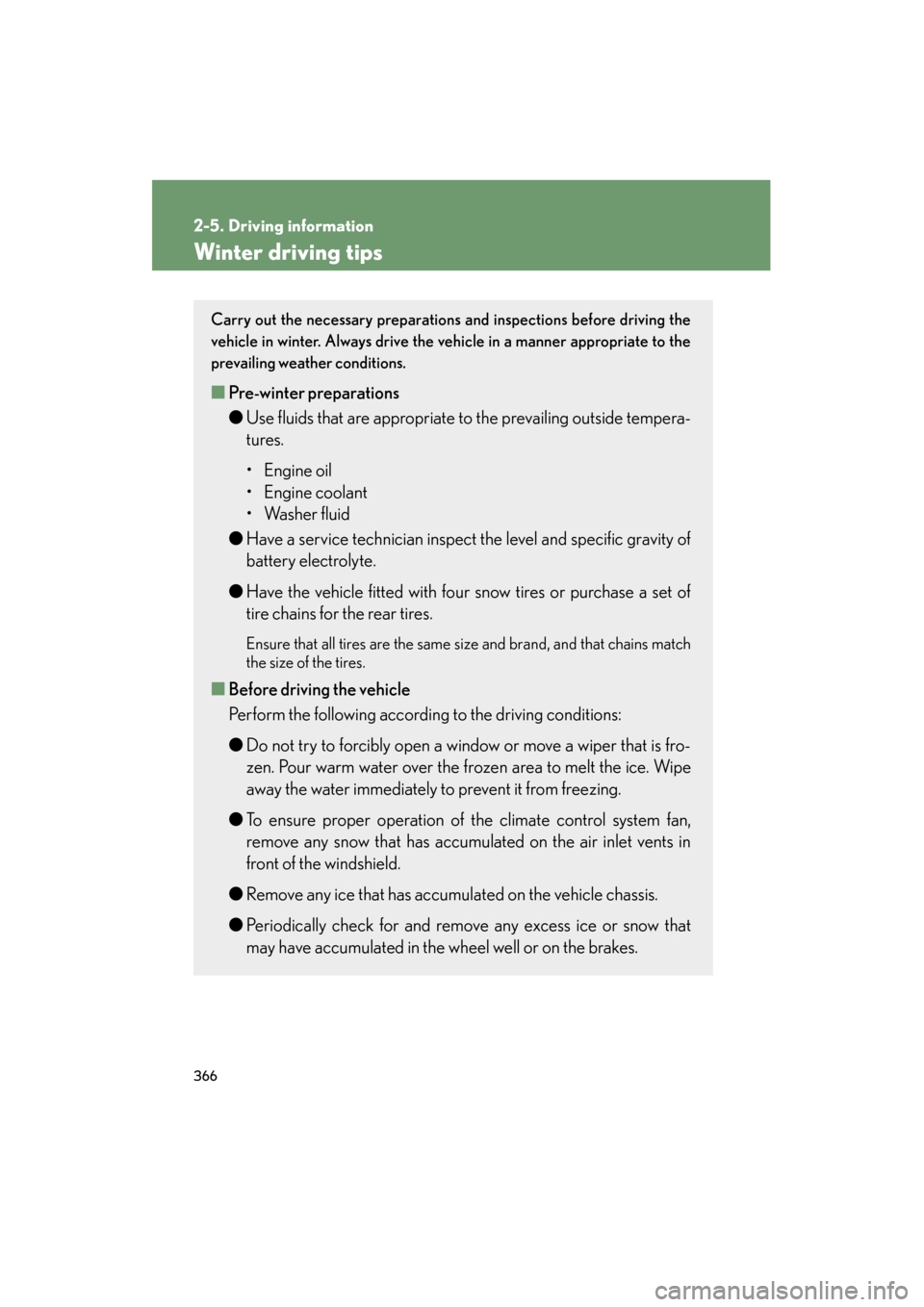
366
2-5. Driving information
GX460_U.S.A. (OM60J00U)
Winter driving tips
Carry out the necessary preparations and inspections before driving the
vehicle in winter. Always drive the vehicle in a manner appropriate to the
prevailing weather conditions.
■Pre-winter preparations
●Use fluids that are appropriate to the prevailing outside tempera-
tures.
• Engine oil
• Engine coolant
• Washer fluid
● Have a service technician inspect the level and specific gravity of
battery electrolyte.
● Have the vehicle fitted with four snow tires or purchase a set of
tire chains for the rear tires.
Ensure that all tires are the same size and brand, and that chains match
the size of the tires.
■ Before driving the vehicle
Perform the following according to the driving conditions:
●Do not try to forcibly open a window or move a wiper that is fro-
zen. Pour warm water over the frozen area to melt the ice. Wipe
away the water immediately to prevent it from freezing.
● To ensure proper operation of the climate control system fan,
remove any snow that has accumulated on the air inlet vents in
front of the windshield.
● Remove any ice that has accumulated on the vehicle chassis.
● Periodically check for and remove any excess ice or snow that
may have accumulated in the wheel well or on the brakes.
Page 369 of 839
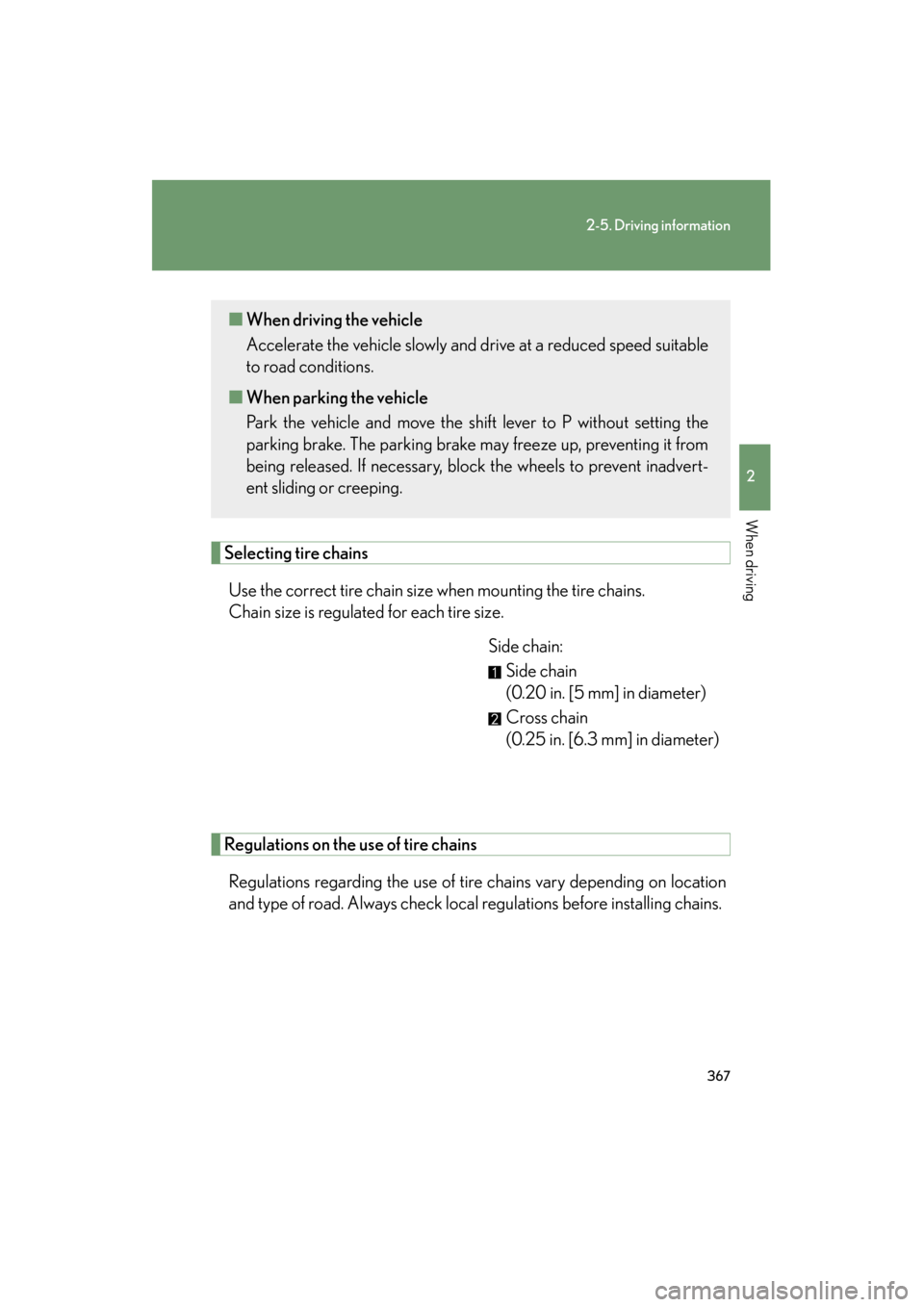
367
2-5. Driving information
2
When driving
GX460_U.S.A. (OM60J00U)
Selecting tire chainsUse the correct tire chain size when mounting the tire chains.
Chain size is regulated for each tire size. Side chain:Side chain
(0.20 in. [5 mm] in diameter)
Cross chain
(0.25 in. [6.3 mm] in diameter)
Regulations on the use of tire chains
Regulations regarding the use of tire chains vary depending on location
and type of road. Always check local regulations before installing chains.
■ When driving the vehicle
Accelerate the vehicle slowly and drive at a reduced speed suitable
to road conditions.
■ When parking the vehicle
Park the vehicle and move the shift lever to P without setting the
parking brake. The parking brake may freeze up, preventing it from
being released. If necessary, block the wheels to prevent inadvert-
ent sliding or creeping.
Page 370 of 839
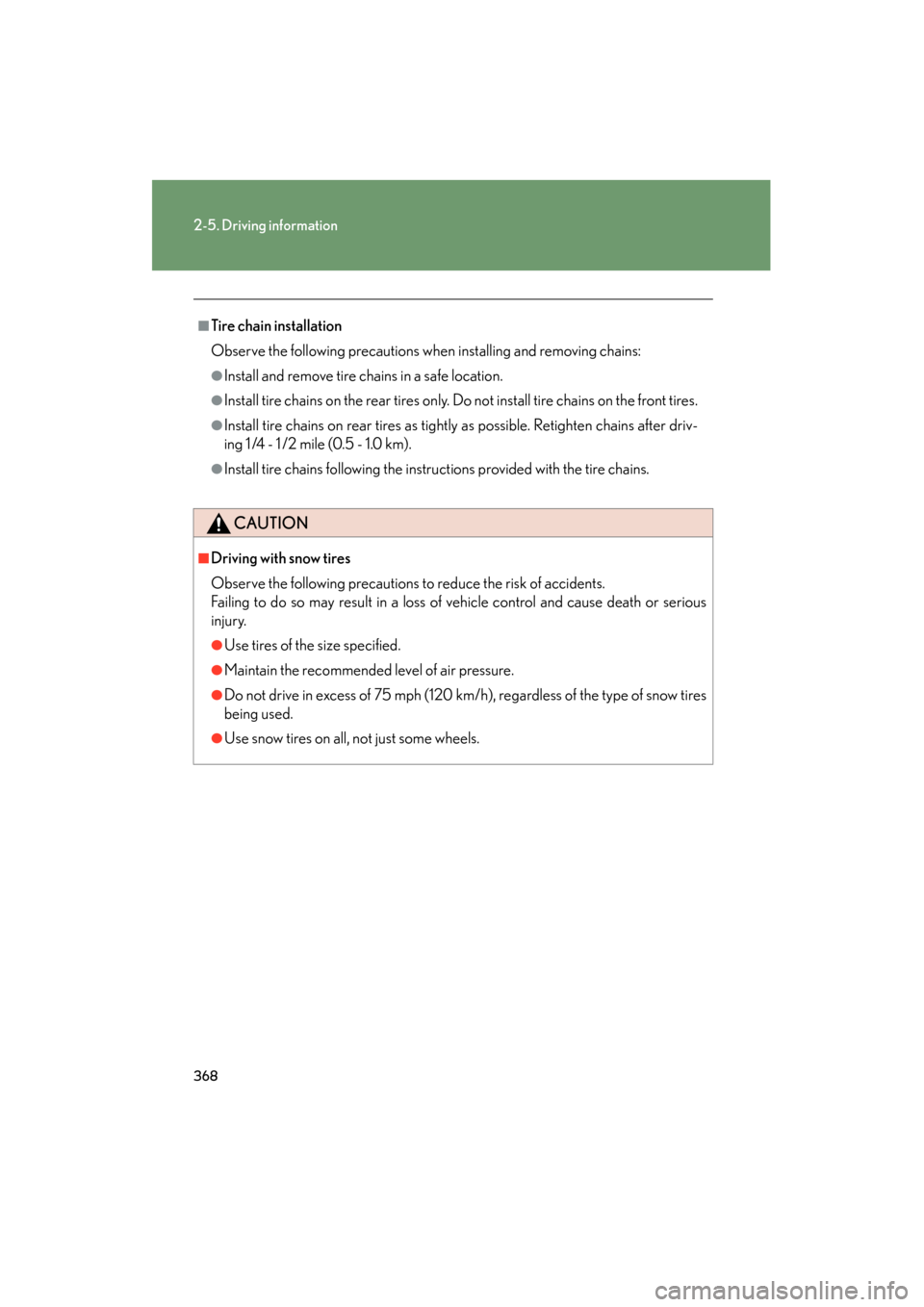
368
2-5. Driving information
GX460_U.S.A. (OM60J00U)
■Tire chain installation
Observe the following precautions when installing and removing chains:
●Install and remove tire chains in a safe location.
●Install tire chains on the rear tires only. Do not install tire chains on the front tires.
●Install tire chains on rear tires as tightly as possible. Retighten chains after driv-
ing 1/4 - 1/2 mile (0.5 - 1.0 km).
●Install tire chains following the instructions provided with the tire chains.
CAUTION
■Driving with snow tires
Observe the following precautions to reduce the risk of accidents.
Failing to do so may result in a loss of vehicle control and cause death or serious
injury.
●Use tires of the size specified.
●Maintain the recommended level of air pressure.
●Do not drive in excess of 75 mph (120 km/h), regardless of the type of snow tires
being used.
●Use snow tires on all, not just some wheels.